Artists and brothers, Jose and Rey Parla each have unique and recognizable visions. Born into a family of Cuban exiles, they moved to Puerto Rico at very early ages to return to Miami again before they were teenagers. They both currently live and work in Brooklyn, NY. Two weeks ago I had a studio visit with Jose and Rey. Knowing each other since the year 2000 we caught up about their latest projects. It was such a thrill to see all of the work – finished or in progress, their work truly moves me.
Jose’s bodies of work, particularly his paintings, are a combination of memories and experiences, from the many cities he has moved through since childhood and throughout his life. Through these diverse locations, each painting holds the textures, colors and pulse of each place. The walls in which he draws direct inspiration from, hold years of decay and neglect from the layers of paint, to decades of old posters.
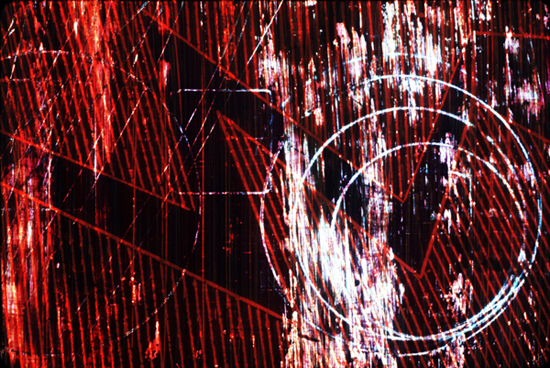
"Scratch Graph 1" 2007, © Rey Parla
Rey creates abstract works, which combine film, photography, paint and ink materials. These images are not computer-generated, but are hand-manipulated experimental motion picture based works that create a new kind of a “non-photo” photograph.
Jose Parlá’s works have appeared in major exhibitions in London, New York, Tokyo, Hong Kong and Paris, and recently in Stages for the Livestrong Foundation at Galerie Emmanuel Perrotin in Paris, Deitch Projects, New York, and O.H.W.O.W in Miami. This summer both Rey and Jose were part of the traveling exhibition, The New Grand Tour at Bryce Wolkowitz Gallery.
Just in time for Art Basel, The Parla Brothers will be showing at: It Aint Fair 2010, O.H.W.O.W Gallery, Art Basel Miami Beach 2010 from December 2 – January 8, 2011.
Carissa Pelleteri: How is it working together as brothers?
Jose Parla: Rey and I have been having conversation about art and philosophy since we were kids. We’ve always been best friends and also kept great friends around us who are creative and share into our lifestyle as artists. It is very natural for us as brothers to build work together. We’ve often felt that it is, us against the world, and that we are lucky to have each other. We both love making art and use art as a way to defeat our struggles.
Rey Parla: José and I have been working together since our early teens. We have always encouraged and inspired each other to set challenges for personal creative work that carries in it a dialogue for our ongoing conversations about life and art. Working together once again is a natural progression through time that has further matured into a mutual synergy of thoughts and ideas we have fun in sharing with each other.
CP: In the earlier years Jose, you painted the walls with the name “Ease” and Rey, you experimented with Super 8 film and shot photographs.
JP: The name Ease comes from 1983 when I first got introduced to Hip-Hop culture by our friend Jesus Ortiz in Miami. He and Rey gave me the name one day after school when we were practicing break-dancing. I used the name Ease for 25 years steadily and after our father passed away, I used the name less and less. Now I use my given name being that it is the same as my father’s name.
RP: For a while I wrote – Faz, but after voluntarily deciding to document the writing scene in Miami starting in the early 1980s and successfully creating an archive of photographs of the writing subculture in our hometown, I then fully turned my lens on my brother José. I was using various cameras back then and it was all from a self-taught perspective. The documentation on Super 8 film was also DIY. I was involved with the Alliance Film & Video Co-operative on Miami Beach and was able to rent Super 8 and 16mm cameras after taking some courses there. My first Super 8 film was a short abstract documentary on José, titled: An Experimental Introduction to a Segmented Reality. I continued to document our friends and José painting and also worked on three short absolute films in the tradition of Visual Music animation. The films were all screened at film festivals and galleries in Miami during the 90s.
CP: Jose, When did you have your first inclination to take your street graffiti to canvas on a grand scale? Was there a magic moment or chain of events that lead to this?
JP: What I was doing on walls around the city was always the same as painting on canvas to me. The only difference is that people were interested in collecting the canvases. At the same time I was painting walls, I would keep sketchbooks and would also practice painting on canvas since I was very young. During the mid-eighties I was aware of the work New York writers like: Lee, Futura, Crash and Daze and even Jean-Michel Basquiat, and Keith Haring were making. I was interested in making works on canvas and at the same time to remain very true to painting around the city as well. The first time I was part of an underground art exhibition was probably in 1988 before I earned a scholarship to study art in Savannah, Georgia. By 1989, although I was still heavy into painting walls, I was making paintings on canvas in a grand scale as well.
CP: Tell me about “Brothers Back 2 Back.”
JP: The painting, Brothers Back to Back, was made in 2006. This painting is made in the style of a palimpsest and is layered with the writing of many memories shared between Rey and I as brothers growing up in Miami. There was a lot of tension and danger in the streets when we were kids, and maybe it is still like that, but not quite like in the 1980s I think. Brothers Back to Back was the saying we had to mean we would protect each other. Its meaning was that we could see if anyone was coming at us from any direction. Originally I made a drawing in 1987 that was of Rey and I standing in B-Boy poses with our backs to each other.
CP: Jose, your paintings come from locations around the world and life experiences. Are there specific cultures or subcultures, which have had a major impact in your work?
JP: Traveling in general has always been a major part of my inspiration. Even as kids, traveling into new neighborhoods and discovering new places to paint was a great experience. We were together with a crew of other artists searching and discovering new hidden train tracks, freight trains, trucks, or rooftop walls around the city on which to paint. This expanded as I evolved into traveling to other cities to go paint as well. Later on after seeing so many parts of different cities, I had noticed that so much of what I was looking at was deteriorated walls, abandoned buildings, old train stations, with mold on the walls, rust marks, years of writing on walls layered over each other, paint peeling away and exposing written tags underneath, layers of posters also peeling and exposing more of the walls’ histories. During my travels I would see walls like this everywhere in London, Tokyo, Beijing, Havana, Istanbul, San Salvador and many other cities. All of this started to inform my paintings. A painting professor of mine once said that a painting must have history within it and I liked very much her philosophy. I wanted to create transparencies in my work and by using the walls as a point of departure I felt it was natural being that at that point I had been around walls for most of my life.
CP: Jose, tell me more about the Concord Project, commissioned by the city of Toronto. Those murals are huge!
JP: The two mural paintings were commissioned by Concord City Place in Toronto for the lobbies of two residential buildings. One is sixty-five feet in length and the second is thirty-five feet in length. I made them both in my Brooklyn studio and we recently installed them in their permanent location in downtown Toronto. The larger one is titled: The Names that Live and Sometimes Fade while Time Flies. This is a painting made of layers of names. The painting pays homage to artists who I admire and have worked with, some who are friends as well. The smaller painting is titled: The Bridge. It pays homage to the city, which to me is like a bridge, which allows me to get across and to do the things I dream of.

"Intuitive Provocation. Redacted Frame No. 9" 2010, © Rey Parla
CP: Rey, what are your influences and inspirations in how you create your work?
RP: During my teenage years and up to my early twenties, I really enjoyed and thought about the work of Futura 2000 as well as the writers influenced by a style called, Computer Rock. We didn’t fully call this Graffiti back then, the media labeled it that way. For us it was a self-taught, DIY realm, maybe we can even call it outsider art or folk street art created on the subway trains of New York City during the 70’s and 80s. The colors, the abstractions and the idea of art moving and being viewed momentarily was and remains a hyper kinetic influence that is substantial to my artistic vision.
I was turned on to filmmaking by my father who had made some short films at the ICAIC (Cuban Institute of Cinematographic Art and Industry) and began to film my friends and brother José doing their works on walls in around Florida, Georgia and New York State. Only after I was heavily involved and living the art of documenting the writing subculture in Miami and the East coast, and being influenced by my brother’s painting philosophy and methods did I accidentally create a film titled: Sporadic Germination. The experience of making and screening this film along Stan Brakhage’s work and the work of Jose Antonio Sistiaga from Spain at The Miami International Film Festival: The Avant-Garde Returns, introduced me to the vast experimental film canon world wide. These early experiences continue to influence and inspire me to create new works.
CP: Rey, tell me about your new work HYPER: Scratch | Graph, which is being shown at O.H.W.O.W.’s It Ain’t Fair group show.
RP: This particular new piece continues my physical “haptic” approach to image making. I have always been interested in opacity, transparency, the layering of marks, and their effects. With this work I have combined various working methods from light experiments conducted in my motion picture based works where I have manipulated both positive and negative space. I am drawing with light and also creating a new kind of photograph.
The inspiration for HYPER: Scratch | Graph comes from the idea of capturing the times now. Our story now is one of hyperkinetic activity of interconnected networks, firewalls, masks, sub-pseudo identities, waves of psycho-geographical mental layers continuously discovering and exploring the new sea of shared knowledge. Lines, human lines and boundless borders. A handcrafted mirror reflecting the image of the world as we know it. The work is about the future of now which registers our constant flux, our movements and at the same time a hyper static contraction into a memory of the past, a part of death and rebirth that seem to always inform the human condition, the piece is an abstract representation of our present nature.
artists website:

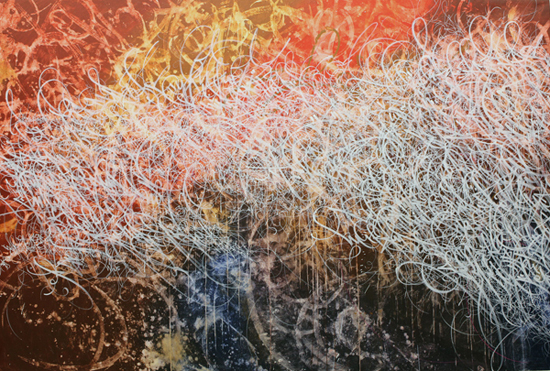


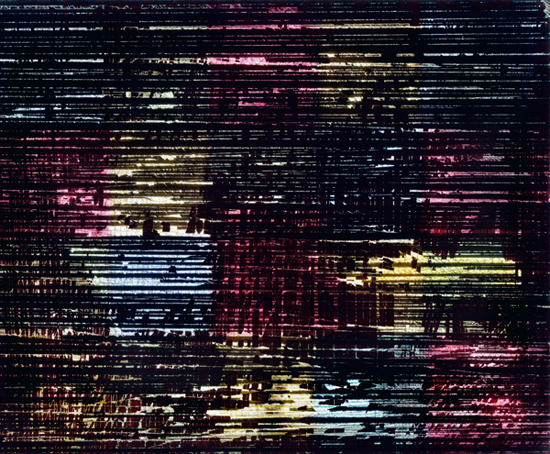
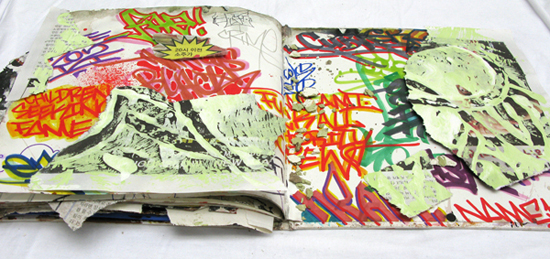

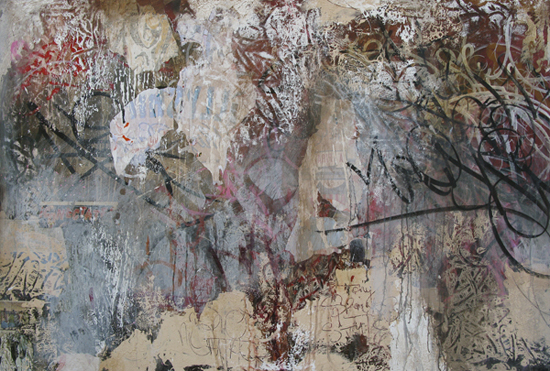


 RSS
RSS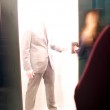

Very informative! Enjoyed the Q&A format.
November 30, 2010 @ 2:06 pm
wonderful expressions and forms!
November 30, 2010 @ 7:44 pm
You Guy’s are amazing,Very Proud Of You!!!We Love Your work!!!!
March 10, 2011 @ 1:23 am